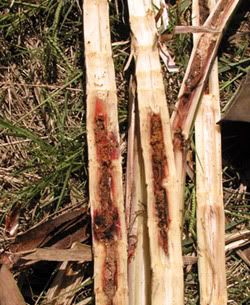CIRAD beats major sugar cane pest
 All renewable energy technologies carry their own specific risks and dangers. In the case of bioenergy and its feedstocks, most of those are related to agro-climatic factors (droughts, pests, plant diseases).
All renewable energy technologies carry their own specific risks and dangers. In the case of bioenergy and its feedstocks, most of those are related to agro-climatic factors (droughts, pests, plant diseases).In a breakthrough [*.French], the Centre de coopération internationale en recherche agronomique pour le développement (CIRAD), a major research organisation focusing on agriculture in the South, and the South African Sugar Research Institute (SASRI), have succeeded in winning the fight against one such a risk, namely the African sugar-cane boring moth, a top enemy for phytopathologists.
Eldana saccharina, as the insect is known, is one of the most threatening pests to sugar cane production. With 20,4 million hectares under cultivation, sugar cane is a crop of global importance. Sugarcane is experiencing an unprecedented boom because of its use as an ethanol and biomass feedstock. Smallholders make up around 30% of world production, contributing some 145 million tonnes of sugar, 76% of which is derived from cane.
Sugar cane plantations are attacked by numerous pests, making them fragile, certainly for smallholders who often have limited means for professional integrated pest management. Most of the damages are caused by moths such as the African sugar-cane borer whose caterpillars eath away the cane stems and feed on the sugar and the green biomass. The economic losses are considerable: estimates from the island of Réunion have shown that infested plantations (where 90% of the canes are colonised and 20% perforated by larvae and caterpillars), may lose up to 30 tonnes of biomass per hectare.
Chemical and biological approaches failed
The success of the moth is due to the fact that its larvae and caterpillars live inside the stems and are thus protected against pesticide spraying. Biological approaches (using predators such as fungi or other insects) haven't shown encouraging results either. So the researchers at the CIRAD/SASRI looked at other options and they focused down on identifying the agronomic factors which limit the growth of the pest:
 ethanol :: biomass :: bioenergy :: biofuels :: energy :: sustainability :: sugar cane :: pests :: pest-management ::
ethanol :: biomass :: bioenergy :: biofuels :: energy :: sustainability :: sugar cane :: pests :: pest-management :: During three years, from 2004 to 2006, both research organisations launched a vast program in South Africa, one of the world's leading producers. The approach was based on agro-ecological principles, and consisted of inducing water stress on the plant and of increasing the concentration of silica in the plant tissue.
The results of laboratory and greenhouse experiments are encouraging: the introduction of silica shows a great reduction in damages for all cane varieties, with or without water stress. For the very sensitive varieties that were placed under water stress, the damages were even lower, and comparable to pest-resistant sugar cane varieties.
The researchers now estimate that this silica based method may reduce 20 to 30% of the losses in sugar and biomass experienced by the most sensitive varieties. Moreover, the increased amount of silicium does not alter the strength of the stems. No major impacts on the quality of the sugar were observed either.
Silica, a wall against larvae
One hypothesis concerning the active role of soluble silica in the way the plant strengthens its defense system was brought forward: if placed under hyrdo-stress, the lack of water possibly induces modifications both in the concentration and structure of the silica inside the plant tissues. These modifications probably result in the creation of a kind of strong silica wall which the larvae find difficult to break down. However, this wall is produced without modifications to the overall strength of the tissue.
Another hypothesis comes down to the idea that the induced changes reinforce the natural defense mechanisms of the plant, be they of a chemical or physiological nature. These mechanisms still have to be analysed further, which is why CIRAD, in collaboration with the University of Kwazulu Natal have launched a project that will study the role of the silica inside the plant and on its defense system.
The first results of the new approach against the caterpillars and larvae are so promising that they may become the preferred pest-management method in the future. Especially in (South) Africa, there is great interest in the method because many soils on the continent (over 60% in South Africa) are silica-deficient. Moreover, this deficiency can often be found in combination with a lack of water, which increases the risk of infestations.
The researchers hope to take their work out of the laboratory and into the field in 2007, to develop a pest management method based on adding calcium silicate to the soils. After these trials, the method will be made available to agricultural organisations, cane producers associations and individual producers.
 -------------------
-------------------
 Spanish company Ferry Group is to invest €42/US$55.2 million in a project for the production of biomass fuel pellets in Bulgaria.
The 3-year project consists of establishing plantations of paulownia trees near the city of Tran. Paulownia is a fast-growing tree used for the commercial production of fuel pellets.
Spanish company Ferry Group is to invest €42/US$55.2 million in a project for the production of biomass fuel pellets in Bulgaria.
The 3-year project consists of establishing plantations of paulownia trees near the city of Tran. Paulownia is a fast-growing tree used for the commercial production of fuel pellets.









0 Comments:
Post a Comment
Links to this post:
Create a Link
<< Home